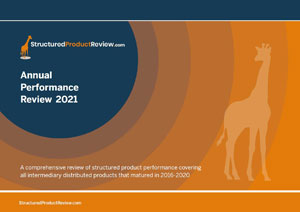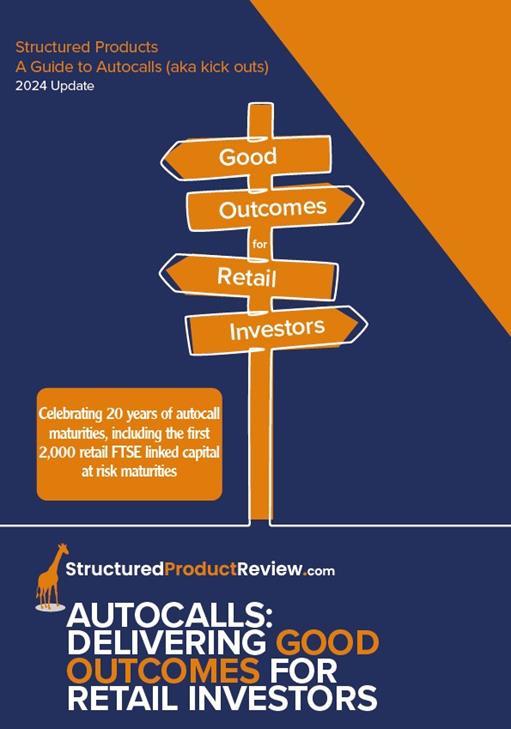Max Darer, Lowes Financial Management, 31/08/2023
Contingent income plans offer a high regular income payment to the investor, generally on a quarterly basis but dependent on a position of the underlying index or stock. A generic FTSE 100 linked contingent income plan offered today will pay x% per quarter if the FTSE 100 is no more than 25% below the initial index level recorded on each quarterly observation date. If the index is below this level then no income will be paid for that quarter.
What contingent income plans offer therefore is a fixed level of income dependent on the FTSE 100 performance and irrespective of the dividend yield of the FTSE 100 and other factors. Furthermore, contingent income plans offer a built-in capital protection at the end of the term if the FTSE has fallen by up to say, 35%.
Investors seeking an income are usually doing so for that guarantee and certainty, perhaps to meet known regular costs. Income through contingent plans will generally be higher than through traditional vehicles as compensation for taking on the conditional element with income subject to market risk. The tradeoff is acceptable where the investor is willing to possibly cede income payments.
It is typical for conditional income plans to include pre-defined annual or even quarterly kick-outs that mean the investment will terminate if say the FTSE is at or above 105% of its initial level on pre-set observation dates. This introduces another risk to investor’s income objectives where the maturity means they need to re-invest on potentially differing terms.
Looking at historical backtesting since 1984 of a maximum 9 year FTSE 100 linked plan with a 65% end of term barrier, annual 105% kick-out observations, we can demonstrate how long contingent income plans will typically pay an income for.
|
Total possible start dates: |
10280 |
|
Of which, yet to reach 1st kick-out |
507 |
|
Total possible maturity dates |
9773 |
Total number of maturity outcomes (% of total possible)
Historical backtest with 105% annual kick-outs
|
Matured 2nd year |
6393 (65.4%) |
|
Matured 3rd year |
865 (8.9%) |
|
Matured year 4-8 |
1358 (13.9%) |
|
Matured final year |
488 (5.0%) |
|
Matured with a loss |
93 (0.95%) |
|
Yet to mature |
576 (5.9%) |
Just 5.95% of historical start dates would have seen the plan run to the final year with 0.95% of these witnessing a breach of the capital protection barrier resulting in less than invested capital being returned.
Over 65% of historical start dates would have seen the plan terminate on its first observable date thereby cutting the income payments short and forcing reinvestment. On the flip side early maturity dates for income plans add protection from risk of loss. This highlights a fine line between capital protection focus and a consistent income stream.
Backtesting indicates that reducing the kick-out level to 100% of initial index level, rather than 105% significantly increases the likelihood that maturity occurs on the first possible observation whilst reducing the chance of the plan running the full 9-year term. There is however only a small improvement on potential for capital loss.
Historical backtest with at-the-money annual kick-outs
|
Matured 2nd year |
7191 (73.6%) |
|
Matured 3rd year |
725 (7.4%) |
|
Matured year 4-8 |
1433 (14.7%) |
|
Matured final year |
138 (1.4%) |
|
Matured with a loss |
72 (0.74%) |
|
Yet to mature |
214 (2.2%) |
If we increase the required kick-out level to a 10% rise in the FTSE 100, the possibility is an extended income paying term, yet with only a marginal increase in historical losses when compared to a 105% level.
Historical backtest with 110% annual kick-outs
|
Matured 2nd year |
5434 (55.6%) |
|
Matured 3rd year |
1021 (10.4%) |
|
Matured year 4-8 |
1388 (14.2%) |
|
Matured final year |
916 (9.4%) |
|
Matured with a loss |
99 (1.01%) |
|
Yet to mature |
915 (9.4%) |
The lower likelihood of an early termination through a higher kick-out level will however translate to a lower potential return.
The first FTSE 100 linked contingent income plan matured in February 2008, offered a potential 10% annual income over the 3-year term, providing that the FTSE 100 did not rise or fall by 10% or more over the annual measurement period. The FTSE level was reset on each subsequent anniversary date. Being a capital ‘protected’ plan, after three years, invested capital was returned in full but no income was paid – at all!
The 239 capital at risk contingent income plans realised an average annualised return of 5.73% over an average term of 3.9 years.
143 of these had potential to mature early based solely on the level of the FTSE 100 on maturity trigger dates. 141 of these plans did in fact mature early thus stopping future income payments and returning invested capital in full. On an average annualised basis the 143 FTSE 100 contingent income kick-out plans returned 5.69% over an average term of 2.6 years, this translates to an average total income paid for the 143 plans of 15.8%.
By comparing those with potential kick-outs to those without, the 96 plans without potential early maturity gave average annualised return of 5.78% over 5.8 years, translating to 38.7% in average total income.
The backtesting data clearly correlates with the actual performance seen in that given the chance to kick out if the FTSE rises it will do, therefore providing income for a shorter period. For an investor requiring a regular income over a fixed period, it is clear that plans with possible early maturity will see the income stream end early. The upside is that there is regular issuance of contingent income plans therefore helping investors’ reduce reinvestment risk.
FTSE 100 contingent income plan maturities 2008 - Aug 2023
|
Capital at risk |
Deposit-based* |
|
|
Number Maturing at a gain |
239 |
89 |
|
Number Maturing at a loss |
0 |
0 |
|
Number returning capital only |
0 |
1 |
|
Average annualised return |
5.73% |
4.53% |
|
Lower Quartile |
4.70% |
4.40% |
|
Upper Quartile |
6.84% |
5.77% |
|
Average term |
3.90 years |
5.18 years |
|
Average advertised maximum term |
7.09 years |
5.19 years |
All data sourced from StructuredProductReview.com
Structured investments put capital at risk.
Past performance is not indicative of future results.
Also in this section
- How old is too old? Are structured products to die for?
- Product focus - October 2024
- Q3 2024 Issuance
- Q3 2024 maturity results
- A share of spread bets on steroids?
- Product focus - September 2024
- Maturities of the month - August 2024
- Right on time
- Product focus - August 2024
- Keep calm and zoom out
- 2,000 and counting
- Q2 2024 maturity results
- 20 years of autocall maturities
- Product focus - June 2024
- Fixed income or interest?
- Maturities of the month - May 2024
- The barrier debate - revisited
- Product focus - April 2024
- Maturities of the month - April 2024
- Time to call
- I don't believe markets are ever too high for Structured products!
- Notes on counterparty exposure
- Return of Nikkei
- Q1 2024 issuance
- Q1 2024 maturity results
- Structured Products – AAAAAGH!
- Hop in CIBC
- Re-enter Santander
- How to build a financial fortune - revisited
- Issuance in 2023
- Where's the risk?
- Questionable offerings
- Challenging the case against structured products - 'Loss of dividends'
- Navigating the investment landscape
- Challenging the case against structured products - Counterparty risk
- 6-year autocalls approaching final destination
- 1,750 FTSE capital at risk autocall maturities
- The leopard that changed her spots
- Q3 2023
- Challenging the case against structured products - Keydata
- Dilemmas for UK IFA's and the unique role of Structured Products
- 'High charges'
- Precipice bonds
- Intro
- FTSE 100 Contingent Income
- Indexing the indices
- Something different
- Investing through volatility
- 100 10:10s
- The best or worst?
- The 10%/25% 'Rule' that never was
- Structured products and the yield curve
- Fixed income: Capital at risk?
- Prospects for UK inflation - and fun with A.I!
- The Barrier Debate
- More Deposits for now
- Last of the Americans
- What if?
- Time heals all wounds, we hope...
- How to diversify portfolios using structured products?
- The Proof Is In The Pudding...
- Debunking Structured Misconceptions
- 1,500 FTSE Capital-at-Risk Autocall Maturities
- Q3 2022 Maturity Results
- What do we prefer?
- Deposits vs Capital ‘Protected’
- There’s time yet…
- Where did you invest your clients?
- A Six-Month Reflection
- Return of the Rev Con
- Happy 2nd Birthday FTSE CSDI
- Q2 2022 Maturity Results
- The best and worst yet still the best
- Critique my Suitability - Mariana 10:10 Plan June 2022 (Option 2)
- 10/10 for 55 10:10’s
- Q1 2022 Maturity Results
- 'How to build a financial fortune': a follow up
- Critique my Suitability - Mariana 10:10 Plan April 2022 (Option 2)
- 2021 Capital-at-Risk Autocall Maturity Review
- An unwelcome return...
- CSDI's First Birthday
- Bon Anniversaire
- Introducing the FTSE Custom 100 Synthetic 3.5% Fixed Dividend Index
- Q3 2021 Maturity Results
- Critique my Suitability - Mariana 10:10 Plan October 2021 (Option 2)
- Blurring the lines...
- Beware of false knowledge; it is more dangerous than ignorance
- Good news, bad news...
- Certainty is Certainly a Benefit
- Critique my Suitability - Mariana 10:10 Plan September 2021 (Option 2)
- A Twenty-Year Progression
- Q2 2021 Maturity Results
- Nine 8:8s Post Positive Returns in Falling Markets
- Critique my Suitability
- Q1 2021 Maturity Results
- Morgan Stanley’s Marvelous Maturity Medley
Current Products
We review the UK's retail structured investment sector, providing pertinent support for Professional Advisers and relevant research tools.
View all ⟶


